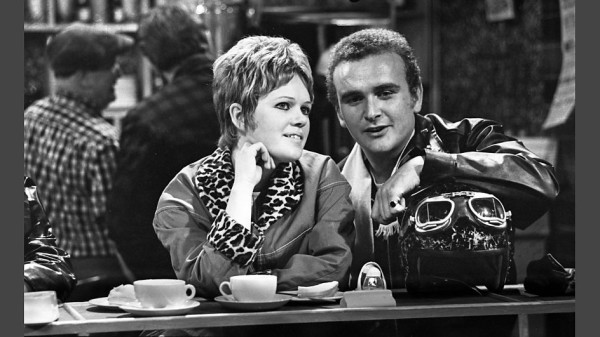
Nell Dunn wrote Up the Junction, her first book, based upon her experiences and overheard conversation while living in 1960s Battersea. The reception of her work was such that she was asked to adapt her work for inclusion in the BBC’s The Wednesday Play series by the young Kenneth Loach, as he was then titled.
The book and the film were unusual for the time both in their subject matter and how they dealt with their subject matter: in focus were the lives of working class people, with no added gloss, and the thorny subject of abortion. Comparisons could be drawn with Alfie (1966) but with a much less managed feel to it. Up the Junction was first transmitted in November 1965 and drew 10 million viewers.
The whole film is dedicated to showing the everyday life and conversations of ordinary people in London; girls lacquering their big hair, three deep at the mirror in the pub toilets, having a laugh on a break from their chocolate factory work and sloping off for illicit encounters in not yet demolished buildings, which showed how damaged London still was after the sustained bombings it received during WW2. There were a few scenes which referred to the illicit encounters, which were much more of a risk in those days. Maybe even more of a risk than messing about on half fallen-down buildings, as contraception was hard to get and legal abortion some way off yet.
The other dark side to the film was the inclusion of the tally man scenes, a person who would go door to door to lend money or to sell things to people who couldn’t really pay it back. These scenes were very cleverly shot by having the tally man in a car, speaking to an unseen passenger. We also see him being openly racist to and ripping off a black man who wanted to buy a suit. The film ends rather sombrely with accidents, people being jailed and the ones who are left, trying to carrying on with their seemingly narrow lives.
After the screening at the excellent East Finchley Phoenix, Nell Dunn discussed both her own and Ken Loach’s contribution to the film. She remarked that one thing the film highlighted now was the difference in what people thought the 1960s were like and what they were actually like. It was known as a decade of free speech, free love and drug-induced merriment but Up the Junction shows a very different picture: “Unless you were married and you could prove you were married, you weren’t allow access to contraception…In some ways it was still a very prim society…It was quite a hypocritical society.”
Dunn said that watching the film after so many years was strange and that the depiction was quite different to what she remembered: “Seeing Battersea again i found quite moving…when I lived there I did think it was quite beautiful…the film made me feel that life was pretty terrible but when I lived there i never thought that, i thought it was wonderful.” When it came to the adaptation, Dunn said that Loach had told her which parts of the book he wanted written for the film. “When i was working on it it was terrific fun… of course the whole thing was done on handheld cameras and a lot of the people weren’t actors.”
When the film was shown on the BBC in 1965, Dunn said that she had received hate mail for the inclusion of the abortion scenes. The part of the film dealing with one character’s unwanted pregnancy (‘of course you don’t want a baby, you’re only 17’) made me extremely sad. Sad for all those girls who had to have an illegal abortion, sometimes ending very badly, and carry on as if nothing had happened, shouldering all the blame for the transgression, as we see in the film. Dunn said: (while writing Up the Junction) I was listening and writing, and very little of it was made up. People were saying things (in the hate mail) like ‘it’s not a true picture of Battersea, we don’t have abortionists’, whereas there was an enormous amount of backstreet abortion. But I suppose because I was young and a writer I didn’t feel the tragedy of it, which I felt much more looking at the film 50 years later.” This highlighted the fact that abortion is one subject which is still not dealt with very much on screen, either in TV or film and that Nell Dunn would still receive hate mail were this film shot in the present day.
As previously mentioned, Dunn said that the film painted a depressing picture of the time but there were also many cheery parts evident, especially those scenes of the friends all going to do their laundry together, having fun and a chat while folding their smalls. Making the best of things. Up the Junction can be considered a valuable record of what life was like in the 1960s and a sterling early example of what the great director Ken Loach went on to produce much more of. Up the Junction went on to be remade into a feature film in 1968.
Maryann has awarded Up the Junction (1965) four Torches of Truth
















{ 0 comments… add one now }